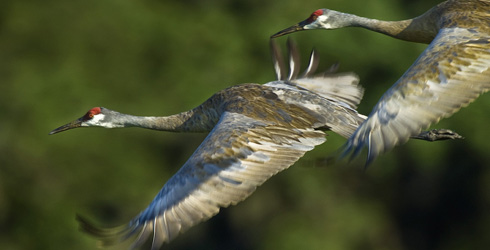
01 Apr The Nature Conservancy: Dance of the Sandhill Cranes
“Spring has sprung,
The Grass has riz,
I wonder where the birdies is?
The little bird is on the wing,
But that’s absurd!
Because the wing is on the bird!”
(Ode to Spring)
“For the birds…” “According to Robert Claiborne in Loose Cannons and Red Herrings, the expression refers to city streets B.C. (Before Cars).
“When I was a youngster on the streets of New York, one could both see and smell the emissions of horse-drawn wagons. Since there was no way of controlling these emissions, they, or the undigested oats in them, served to nourish a large population of English sparrows. If you say something’s for the birds, you’re politely saying it’s horseshit.”
But in the vernacular of gonzo birders Ted Floyd and Bill Schmoker, “trivial” and “worthless” became “profound” and “worthwhile,” and “The Dance of the Sandhill Cranes,” a very special Nature Conservancy weekend so seamless, so magical we hardly noticed the astonishing engineering that made it all work – just like bird feathers.
Over the first weekend in Spring 2015, under the expert guidance of our fearless leaders – Ted, Bill and the team from the Colorado chapter of The Nature Conservancy: Audrey Wolk, director of outreach; Mandy Timbers, associate director of philanthropy; and Alston Williamson, donor relations manager – a group of nine women explored the Monte Vista National Wildlife Refuge, Great Sand Dunes National Park, and the Mendano-Zapata Ranch during the peak of the cranes’ spring passage, when a flashy flap of wings and a do-si-do determines a partner in flight.
Ground Zero was TNC’s premiere preserve in Colorado, the Zapata Ranch.
The 103,000-acre bison and guest ranch, sold to TNC in 1999, is located on the eastern wall of the San Luis Valley in Southern Colorado, bordering the Great Dunes National Park and Preserve, the newest national park in the country. The site, replete with grasslands, alpine forests, wetlands, sand dunes, creeks and lush meadows, offers one of the scenic and ecologically diverse landscapes in the U.S.
In addition to a livestock operation, the ranch features working ranch vacations – our talented amateur chef for the weekend owns and operates Stems Garden Design in Denver – educational programs centered around the bison herd, and active, ambitious conservation programs aimed at preserving the surrounding land and promoting biodiversity.
Lodging (comfortable) and meals (delicious) took place under the roofs of the ranch’s renovated historic buildings, the earliest of which dates back to 1876.
In 1993, both the Mendano and Zapata ranches were entered into the National Register of Historic Places.
Ted, who is editor of Birding, the flagship publication of the American Birding Association, and an instructor with that organization, and Bill, past president of the Colorado Field Ornithologists and Colorado/Wyoming regional editor for North American Birds, approached the weekend with the enthusiasm of young boys finding their first shiny penny on the ground. The dynamic duo, along with Audrey of TNC, fairy-dusted our Dance of the Sandhill Cranes adventure with insights and eloquence.
Read on for details and images from “Ted & Bill’s Excellent Adventure” (And thanks to fellow traveler Susan Dalton for the nifty headline):
With Bill Schmoker and a baker’s dozen of participants in a TNC-Colorado Naturalist’s Workshop, I enjoyed fine birding, superb natural history overall, and brilliant company this past weekend, Friday-Sunday, Mar. 20-22, in the San Luis Valley. Our main day afield was the first full day of Spring, Saturday, Mar. 21: clear, utterly calm (huh? in the San Luis Valley?), and mild.
I intended to sleep in Saturday, but the owls around the Zapata Ranch headquarters, Alamosa Co., put the kibosh on that. I’m pretty sure a male great horned owl was hooting from the roof right over my head. I stepped outside and instantly heard a western screech-owl. Then a couple long-eared owls. Then a northern saw-whet owl. All that without leaving the yard. Next it was up the entrance road and down a service road in the perfect darkness. Visible: the Milky Way, gloriously so; and three wing-clapping long-eared owls in a clearing. Audible: at least three more long-ears; three great horns; male and female saw-whets; and a screech-owl that wouldn’t shut up.
The sky was brightening over the Sangre de Cristos, so it was over to the dune sea along Lane 6, Alamosa Co., for sunrise. The surround-sound sage thrashers there were nice, but the real show-stoppers were the sagebrush sparrows, teed up on every greasewood and rabbitbrush. Otherwise, a few horned larks and western meadowlarks, plus a loggerhead shrike that got a talking-to from one of the sagebrush sparrows.
After breakfast, we explored the old Medano Ranch headquarters and vicinity, Alamosa Co. Our very first sighting was of a striking golden eagle on a utility pole right along the road. Mountain bluebirds and Say’s phoebes were paired up (although not with each other) and prospecting for nest sites around the corrals. An acrobatic quintet of high-flying common ravens was stunning in the still blue sky, and a great horned owl at a nest was a crowd-pleaser. One of the ponds held diverse waterfowl, mainly chorusing redheads, but also an unexpected drake red-breasted merganser–the first I’d ever seen in Alamosa, Co. And we heard and saw several dozen long-legged gray birds with red crowns; more on those in a bit…
The Medano Ranch’s non-avian lifeforms put in a good showing: several herds of plains bison, a smattering of wapiti (elk, or, in Utah, “alk”), several North American porcupines, and a den (“hibernaculum”) of garter snakes . (Does anyone know if the snakes are Plains garter snakes, Thamnophis radix?). Insects were elusive, but I think the butterfly was a spring white, and I’d like to think the briefly glimpsed cicindelid was the endemic Great Sand Dunes tiger beetle.
Next was lunch, then a bit of do-your-own-thing time. A few of us explored the grounds of Zapata Ranch proper, a riot of pinyon jays. We believe there were at least 350 of these “flying monkeys” of the bird world; most were in big flocks, but a few were paired up. Also: mountain and western bluebirds, a Clark’s nutcracker or two, a flock of Cassin’s finches, and bushtits aplenty.
The early-season insect fauna around the Zapata Ranch was diverse but flighty. Case in point: the butterflies, generally too fast, too small, and too brief–except for the handsome Milbert’s tortoiseshells; we saw pairs in a couple of places. Small, dark, bee-like robber flies were widespread; genus Laphria, I’m guessing? Gordon the friendly bison stopped by, and a coyote trotted past.
It was getting on toward evening, and we headed over to Monte Vista National Wildlife Refuge, Alamosa Co. On final approach, we drove slow through the town of Monte Vista, so that we could add to our list a whole bunch of birds we hadn’t yet ticked: rock pigeon, Eurasian collared-dove, American crow, European starling, great-tailed grackle, house finch, and house sparrow. How low can you go?
Pretty much our first bird at the refuge was a lost black-capped chickadee, not really what we had in mind. But things got back on track, and we were soon enjoying the sorts of birds one looks for at Monte Vista refuge at this time of year: One of the ponds had ruddy ducks, buffleheads, and lesser scaup; another had many northern pintails and a few cinnamon teal; northern harriers were constantly in sight; and we heard marsh wrens at one juncture. Western chorus frogs were audible everywhere.
The real action was at a pull-off along Alamosa Co. Rd. 8 S, where the several thousand “white-cheeked geese” appeared mainly to be cackling geese. Also three gleamingly white Ross’s geese. And the rare black brant, present at the refuge since the beginning of the week. But the star attraction had to be the sandhill cranes.
We’d been seeing and hearing them in dribs and drabs throughout the day, but we definitely saved the best for last. More than 10,000 sandhill cranes were gathered in the fields and marshes near the intersection of Colo. 15 and Alamosa Co. Rd. 8 S, prancing and capering, tossing down quinoa, and every once in a while putting up in great thundering clouds. I suppose I’m biased, but I think the sandhill cranes of the San Luis Valley have to be counted on any short list of the great natural spectacles in the U.S…
Sunday morning, Mar. 22, after encore performances by the owls, pinyon jays, and sagebrush sparrows, and after a hearty breakfast, and after the obligatory visit to Great Sand Dunes National Park, it was time to disperse….
And so much for identified flying objects.
Our excellent adventure ended the second day of spring, Sunday, March 22, with Ted & Co. going East over the La Veta Pass (and its GPS-incapacitating magnetic anomaly). My group headed north in the direction of the Fata Morgana, a superior mirage that can create the illusion of town like Atlantic City in the middle of nowhere and nothing, but sadly the conditions were wrong. Instead we stopped at a gator farm, founded as an antidote to too many tilapia; and a site known for Unidentified Flying Objects, the infamous UFO Watchtower constructed back in 1999 by Judy Messoline.
Judy’s family, so the story goes, moved to the San Luis Valley from Texas in 1995 with the idea of raising cattle. When their 160-acre parcel turned out to be way too dry for ranching, the family sold their cattle and built a campground with a viewing platform, where guests could witness the strange and to-this-day unexplained phenomena in the night sky around the area.
Cue “One-Eyed One-Horned Flying Purple People Eater.”
Visitors, including five psychics, claim to have individually recognized two distinct vortexes at the site.
But that’s, well, strictly for the birds, right?
About The Nature Conservancy:
The Nature Conservancy is the leading conservation organization working around the world to protect ecologically important lands and waters for nature and people.
The Nature Conservancy Colorado:
Over the last 45 years, The Nature Conservancy in Colorado has protected nearly one million acres and improved 1,000 river miles across the state. With public support, the goal is to continue to protect and restore Colorado’s lands, forests, and waters for future generations.
Each spring, from late February through early April, thousands of Sandhill Cranes stage in the San Luis Valley before proceeding northward to their breeding grounds. They are especially plentiful at Monte Vista National Wildlife Refuge, but they can be seen and heard practically anywhere in the valley.

(LIMITED INTERNAL RIGHTS) July 2006 Polk County, Florida. Sandhill cranes take flight over the Lightsey Cattle Company Ranch. Some cranes migrate throughout North America and others make peninsular Florida their year-round home. Ranches provide their preferred habitats of freshwater marshes, pastures and open woods. Lightsey Cattle Company received the 2006 Environmental Stewardship Award from the National Cattlemen’s Association. Published Article: NCM Autumn 2009. Photo credit: © Carlton Ward, Jr.
The Nature Conservancy and Zapata Ranch. Information here. And book a visit here.
More wonderful images and videos from the weekend, courtesy of Bill Schmoker here.


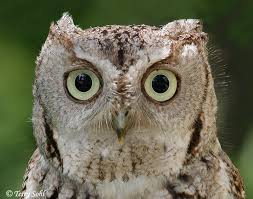
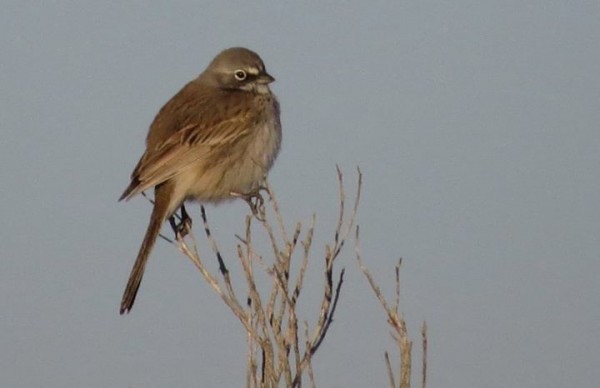
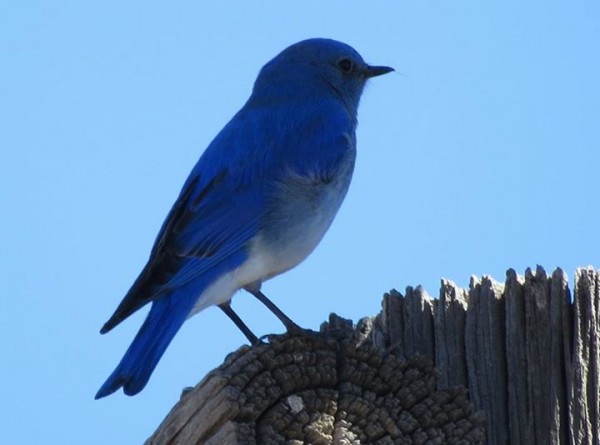
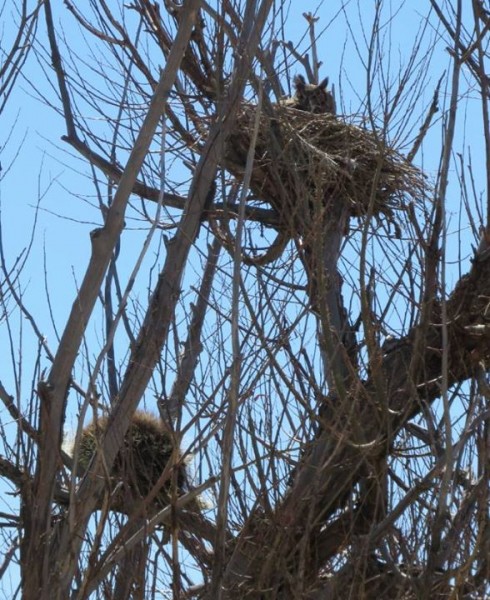
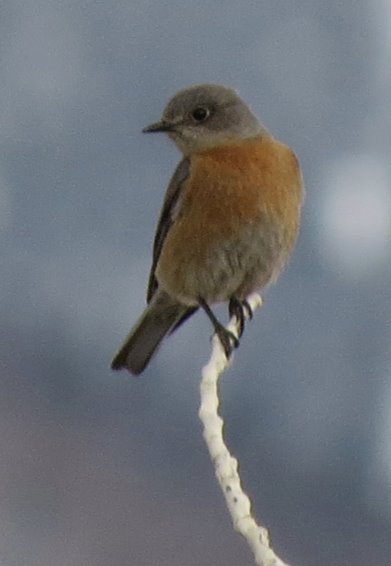
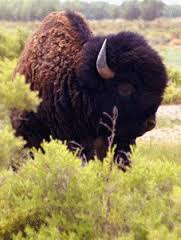


Sorry, the comment form is closed at this time.